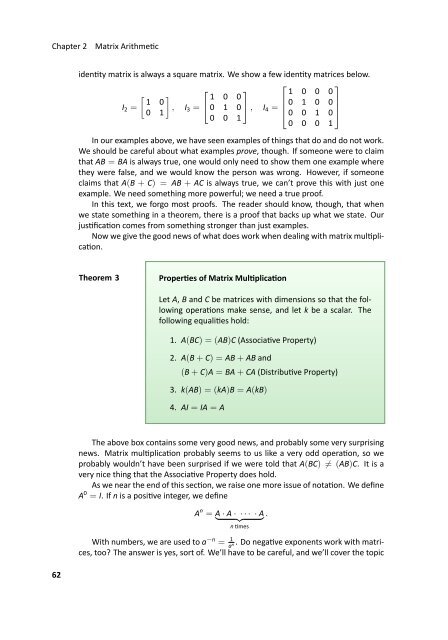Fundamentals of Matrix Algebra, 2011a
Fundamentals of Matrix Algebra, 2011a
Fundamentals of Matrix Algebra, 2011a
Create successful ePaper yourself
Turn your PDF publications into a flip-book with our unique Google optimized e-Paper software.
Chapter 2<br />
<strong>Matrix</strong> Arithmec<br />
identy matrix is always a square matrix. We show a few identy matrices below.<br />
⎡<br />
⎤<br />
⎡<br />
[ ] 1 0<br />
I 2 = , I<br />
0 1 3 = ⎣ 1 0 0 ⎤ 1 0 0 0<br />
0 1 0 ⎦ , I 4 = ⎢ 0 1 0 0<br />
⎥<br />
⎣ 0 0 1 0 ⎦<br />
0 0 1<br />
0 0 0 1<br />
In our examples above, we have seen examples <strong>of</strong> things that do and do not work.<br />
We should be careful about what examples prove, though. If someone were to claim<br />
that AB = BA is always true, one would only need to show them one example where<br />
they were false, and we would know the person was wrong. However, if someone<br />
claims that A(B + C) = AB + AC is always true, we can’t prove this with just one<br />
example. We need something more powerful; we need a true pro<strong>of</strong>.<br />
In this text, we forgo most pro<strong>of</strong>s. The reader should know, though, that when<br />
we state something in a theorem, there is a pro<strong>of</strong> that backs up what we state. Our<br />
jusficaon comes from something stronger than just examples.<br />
Now we give the good news <strong>of</strong> what does work when dealing with matrix mulplicaon.<br />
.<br />
Ṫheorem 3<br />
Properes <strong>of</strong> <strong>Matrix</strong> Mulplicaon<br />
Let A, B and C be matrices with dimensions so that the following<br />
operaons make sense, and let k be a scalar. The<br />
following equalies hold:<br />
.<br />
1. A(BC) = (AB)C (Associave Property)<br />
2. A(B + C) = AB + AB and<br />
(B + C)A = BA + CA (Distribuve Property)<br />
3. k(AB) = (kA)B = A(kB)<br />
4. AI = IA = A<br />
The above box contains some very good news, and probably some very surprising<br />
news. <strong>Matrix</strong> mulplicaon probably seems to us like a very odd operaon, so we<br />
probably wouldn’t have been surprised if we were told that A(BC) ≠ (AB)C. It is a<br />
very nice thing that the Associave Property does hold.<br />
As we near the end <strong>of</strong> this secon, we raise one more issue <strong>of</strong> notaon. We define<br />
A 0 = I. If n is a posive integer, we define<br />
A n =<br />
}<br />
A · A ·<br />
{{<br />
· · · · A<br />
}<br />
.<br />
n mes<br />
With numbers, we are used to a −n = 1 a n . Do negave exponents work with matrices,<br />
too? The answer is yes, sort <strong>of</strong>. We’ll have to be careful, and we’ll cover the topic<br />
62

















